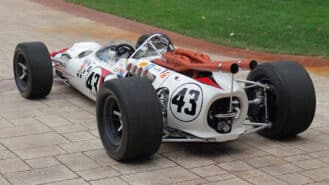
A ‘New Nige’? Foster focused on becoming next British IndyCar star
Louis Foster starts his IndyCar journey this weekend in St Petersburg – can he emulate other British heroes like Nigel Mansell and Dan Wheldon?
Four-time NASCAR champion Jeff Gordon won his last championship in 2001 and in recent years there’s been occasional talk of his possible retirement, but the 42 year old is enjoying a resurgence this year. Gordon has been very competitive in many races and drove an excellent race at Indianapolis last Sunday to score his fifth win in the Brickyard 400 and consolidate his position atop the Sprint Cup point standings. A great day for Gordon who won his first race at Indianapolis 20 years ago in the inaugural Brickyard 400.
But in recent years the overpowering image the Brickyard 400 has been a vast sea of empty seats amid the Speedway’s giant ocean of grandstands. Through its early years from 1994 into the new century the Brickyard 400 drew a pretty good crowd before a steady decline began to take shape, as it has at many NASCAR races, and the race stands out today as a very obvious sore in NASCAR’s frustrating battle to reverse its overall slide in ticket sales and TV ratings.
The fall in the Brickyard’s crowd was exacerbated by a disastrous 2008 race littered with tyre failures. The race was interrupted that year by no fewer than 52 laps of full-course yellows leaving many disgruntled fans and plenty of carping from the media.
A precipitous fall in sales followed and in recent years barely one third of the Speedway’s 230,000 seats have been occupied on race day. In an effort to bolster the flagging crowd NASCAR and the IMS decided two years ago to add a second division Nationwide race on Saturday and a Grand-Am sports car race on Friday. But to no avail. Weak ticket sales and great swathes of empty seats continue. This year’s Nationwide race drew a paltry 15,000 with only a few thousand fans showing up for Friday’s United SportsCar race.
The Brickyard 400 pays just shy of $10 million, NASCAR’s second biggest purse behind only the Daytona 500, and everyone wants to race at the hallowed old track in the heart of America’s Midwest. But you have to ask how the race will continue to make sense both economically and in terms of what these days they call ‘optics’. The more those swathes of empty seats become symbols of NASCAR and the IMS, the less lure it holds for fans, media and sponsors.
A big part of the Brickyard’s dilemma lies in the nature of the Indianapolis Motor Speedway. Unlike most NASCAR tracks, which have only two or three high-banked turns, the IMS comprises four, 90-degree corners banked at a minimal nine degrees. It’s all but impossible for NASCAR stock cars to race side by side on such a track so the race tends to debilitate into an uninspiring show of follow the leader. Nor is it possible to see the entire track from the grandstands so spectators can’t follow everything that’s happening on each lap as they can at all other NASCAR ovals.
Nobody seems to have any solutions to the problems faced by NASCAR at Indianapolis and these issues apparently will continue to fester over the coming years. For my part, I cast my mind back to some vivid recollections from my early years covering the Indy 500 in the mid-70s when unlimited-boost turbo four-cylinder Offenhauser engines churned out more than 1000bhp and the flat-bottom cars of that era carried wings that were literally the size of barn doors.
I have a particular memory of Johnny Rutherford qualifying his McLaren M16C-turbo Offy in those days. Watching Rutherford hustle that beautiful wedge-shaped car around the top of the groove at the Speedway, foot flat on the throttle, turbo Offy four banger wailing like a bomb going off, remains one of the most enduring and spectacular memories I have in more than forty years of watching racing cars in action on all types of tracks.
“The M16 was a fabulous race car,” Rutherford recalls. “It was balanced so well that you could drift it real hard if you needed to. It was an excellent race car. It was neutral, the way I like a car, and with as much as 1200bhp for qualifying, it was something!
“We had the horsepower to overcome the drag of the big, picnic table rear wing and it all came together. We set a new track record at more than 198mph in 1973 and it was a treat to drive.”
In 1974, 10 years before he first raced at Indianapolis, Emerson Fittipaldi tested an M16C-Offy and he loved the car. Emerson says the M16C was one of the best-handling and best-looking cars he’s ever driven and I agree.
My point is we’re talking about just one spectacularly powerful car driven on the limit, not a pack of cars or the inherent spectacle of a race. We’re talking about the attraction of one car running alone on the track and it’s a fact that in those days qualifying for the Indy 500 used to draw more than a quarter of a million fans.
Indy qualifying was the world’s second largest sporting event behind only the 500 itself and the cars were not only spectacular to watch on their own, but they set new track records every year in the hands of great drivers like Foyt, Andretti, Rutherford, Gordon Johncock, Bobby and Al Unser who were legends of American sports culture at the time.
The big crowds continued for many years for both qualifying and the 500 but the huge qualifying crowd vanished almost overnight with the introduction of the IRL in 1996. Raceday crowds for the 500 have also dwindled although they’ve held steady in recent years, a decent crowd to be sure, but nothing like the old days. And over the past ten years we’ve also seen the Brickyard 400’s plunge in popularity. Somewhere in there lays a lesson for all.
Indeed it was the spectacular display that the McLaren M16C of the mid-70s was capable of putting on with the likes of Rutherford at the wheel that left your spine tingling and your mind and memory agog. It was an essential part of motor racing’s appeal over many decades that’s gone from Indy car racing or NASCAR today.
I can’t help thinking that somehow, someway, some of that missing spectacle needs to be re-introduced to the sport, but I’m only too aware that it’s probably impossible to recreate the sport’s great days in the modern world where safety and risk-averse thinking reign.
But surely there’s a message in all those vacant seats at so many American tracks these days, whether they’re NASCAR, IndyCar or United SportsCar races, and that message is the Brickyard 400 stands as the poster child for a debilitating disease the sport must use all its power to try to cure. To not make the effort will be suicidal.

Louis Foster starts his IndyCar journey this weekend in St Petersburg – can he emulate other British heroes like Nigel Mansell and Dan Wheldon?

Myles Rowe has rocketed through IndyCar's junior ladder with a story like no other – he tells James Elson why this upcoming year is more important than ever

Drive to Survive star Will Buxton has made the jump across the Atlantic to front Fox's new IndyCar coverage – he explained to James Elson why he thinks the championship is the most exciting series out there

Jackie Stewart's Lola-Ford IndyCar that failed laps from victory in the 1966 Indy 500 was the star lot in a 16-car auction, selling for $715,000